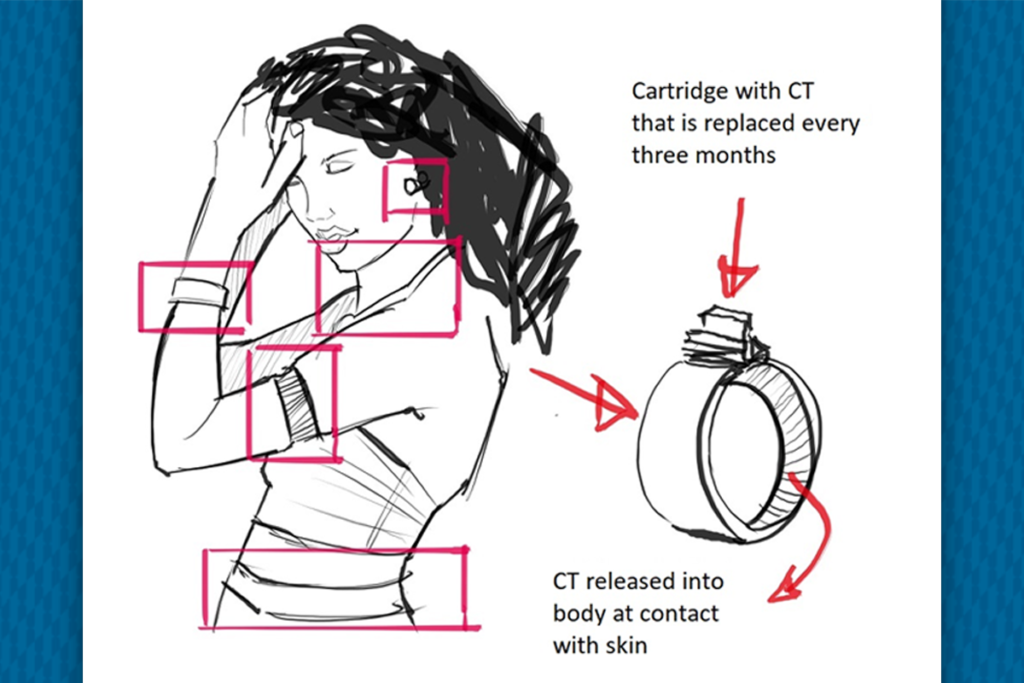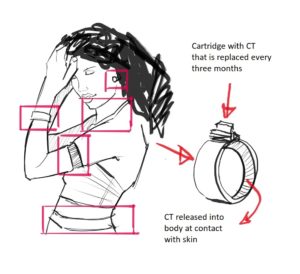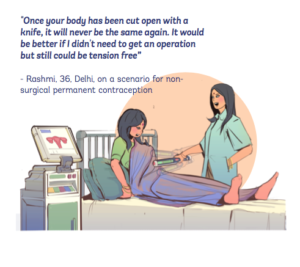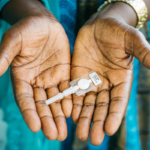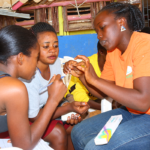By: Anna Lawton (FHI 360) and Babitha George (Quicksand)
This post originally appeared on the Contraceptive Technology Innovation (CTI) Exchange blog.
When it comes to female contraceptive products, innovation has been more evolutionary than revolutionary. With high unmet need still present, a huge opportunity exists to look at new ways to design products that respond to women’s needs and preferences, rather than forcing women to change their behaviors to suit existing products.
Human-centered design (HCD) – also known as user-centered design – is a creative, solutions-based approach to problem solving that puts users (in our case, women) at the center of the product design process. Users are actively engaged at every step to ensure their needs and expectations inform the design. We do this by testing the validity of our assumptions with users themselves, in an iterative fashion. This also allows us to move beyond the existing conditions of “what is” to the forward-thinking potential of “what if”, with sensitivity and empathy.
Using a hybrid HCD + traditional, socio-behavioral approach, we first conducted immersive qualitative research (interviews, focus groups and observations) in several parts of Kenya and India. This helped us get a solid grasp of the day-to-day realities and decision-making considerations of our target users, as well as the drivers and barriers around contraceptive use. Because HCD considers the larger ecosystem of influence and decision-making shaping user attitudes and preferences, our interviews also extended to women’s social networks (e.g., partners, friends, family, community leaders and health providers).
The rich stories, images and insights generated during this research stage formed the foundation for multidisciplinary ideation workshops held in both countries. The goal of the workshops was to spark innovation by engaging both family planning stakeholders and people working outside the field (e.g., general design, product development and manufacturing, public policy and advocacy). Sessions were planned to ensure that the end user’s voice was always active and present. Ideators moved first through immersion exercises to better appreciate the context of women’s daily lives, to “imagineering” what contraception might look like far into the future, to finally generating breakthrough moonshot solutions anchored in these women’s needs.
Ideators generated over 200 new concepts. Two examples, summarized here, highlight how future-facing ideation in HCD is rooted in user needs.
Moonshot concept #1: Contraceptive jewelry
The first example is contraceptive jewelry: an everyday adornment, like a bracelet, belt or earring, with a mechanism that releases contraceptive compounds into the user’s skin.
Here’s how this concept responds to HCD-identified user needs:
- Sex continues to be a taboo topic, especially for unmarried adolescents; many women expressed interest in discreet methods that do not broadcast sexual activity. The ubiquity and popularity of jewelry in both Kenya and India make this a delivery mechanism that women said they could embrace.
- Provider bias around the appropriateness of methods for women at different reproductive stages might impact access and method choice. If contraceptive jewelry were available where women buy fashion and accessories, users would have more control and discretion in selecting methods not subject to provider intervention or bias.
- The “medical” nature of most methods alienates many women and fails to give them a sense of control over something as personal and intimate as contraceptive choice. The accessibility of jewelry removes the “treatment” aspect from contraceptive decision-making.
Moonshot concept #2: Long-acting barrier method
The second example is a long-acting barrier method: a temporary balloon plug inserted endoscopically to block the Fallopian tubes, providing guaranteed contraception that can be reversed at any time by deflating the plug.
Here’s how this concept responds to HCD-identified user needs:
- Some women seek temporary guaranteed protection while others seek to limit their fertility, perhaps after achieving their ideal family size. In some parts of the world, few options outside of surgical sterilization exist for these women. Sterilization, the most widely used contraceptive method in India, comes with significant trade-offs (surgical intervention and its associated risks, recovery pain, opportunity costs from missing work) that can deter its uptake. This moonshot offers women the same efficacy, without major surgery and recovery.
- Sterilization is irreversible; women are unable to change their minds later. This is viewed as an enormous barrier to use for women in Kenya, whose day-to-day world includes the reality that some of their children may die from health causes before they turn five. This fear deters women from considering permanent methods. This moonshot would offer the same protection assurance as sterilization, but be reversible.
- Currently available long-acting reversible hormonal alternatives to sterilization come with their own potential side effects, including pain and changes in menstrual cycle. For many women, these trade-offs are not worth the “tension-free” benefit that long-acting methods provide. This moonshot would offer a long-term solution without physical side effects.
If we truly want to address unmet need for female-based contraceptives, new methods must respect and respond to the real-life challenges women face and the factors influencing their decision-making. With HCD, the opinions of end-users are woven into the design process. This ensures that the final result – be it a product, program, or service – is informed by those who are supposed to reap its benefit, increasing the likelihood of relevance and lasting impact. Now that’s something we can all get behind.
Photo credits: Contraceptive jewelry illustration by Joseph Barasa; clinic bed illustration provided courtesy of Quicksand Design Studio

